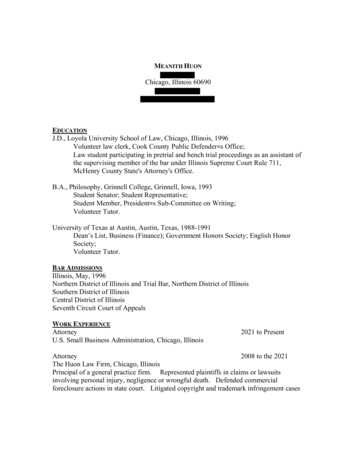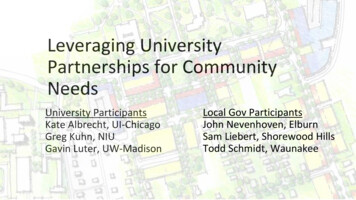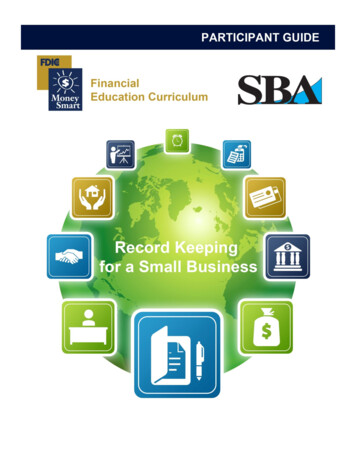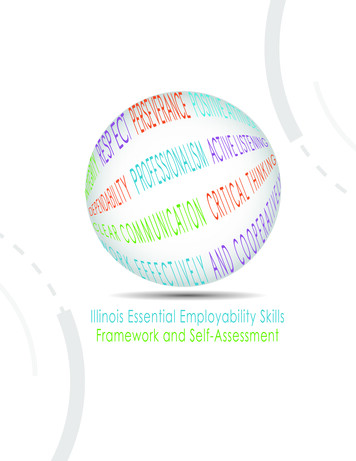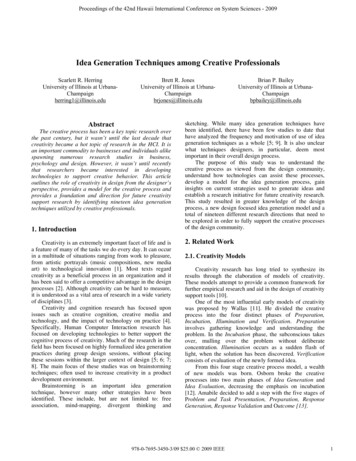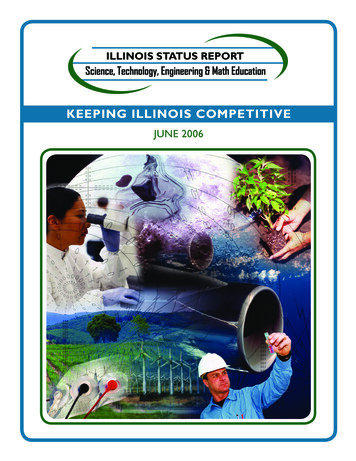
Transcription
ILLINOIS STATUS REPORTScience, Technology, Engineering & Math EducationKEEPING ILLINOIS COMPETITIVEJUNE 2006
iiScience,Technology, Engineering and Mathematics EducationACKNOWLEDGEMENTSNorthern Illinois University P-20 Task ForceThis report is an initiative of Northern Illinois University’sP-20 Task Force. At NIU “P-20” refers to the educationalcontinuum from pre-school through graduate school.For 2005-2007, the P-20 Task Force’s top priority isimprovement of mathematics and science education.www.p20.niu.eduIllinois Business RoundtableThe Illinois Business Roundtable generously provided funding for this report.www.IllinoisBusinessRoundtable.comKeeping Illinois Competitive Report TeamNorthern Illinois University OutreachPenny BillmanMarilyn McConachieLee PattonRachel TurnerKeeping Illinois Competitive on the Webwww.keepingillinoiscompetitive.niu.eduFor information or to order copies,contact NIUOutreach@niu.edu or call toll-free 1-866-855-1239Copyright 2006Northern Illinois UniversityDeKalb, Illinois 60115www.niu.eduJune 2006 Northern Illinois Universitywww.keepingillinoiscompetitive.niu.edu
Illinois STEM Education ReportiiiTABLE OF CONTENTSEXECUTIVE SUMMARY . 1INTRODUCTION . 10TRENDS AFFECTING BUSINESS AND EDUCATION IN ILLINOIS . 13I.Convergence of Demographic, Technological, and Globalization Trends . 14A. The Decline of the Middle Class . 15B. A Projected Shortage of Skilled Workers for the Future. 18C. Increasing Competition Due to Economic Globalization . 22II. The Changing Academic Core: Knowledge and Skills Needed in the 21st Century. 26A. Importance of STEM Education for Everyone . 27B. Changing Knowledge and Skills Needed for 21st Century Workers . 29C. Issues in Implementing the Changing Basic Core. 30INDICATORS OF ILLINOIS STUDENTS’ STEM PERFORMANCE . 32III. Student Achievement . 33A. International Comparisons - United States . 33B. International Comparisons - Illinois . 38C. Illinois and U.S. Comparisons - NAEP . 39D. Illinois State Assessments . 48IV. Readiness for College and Work . 54A. High School Dropout and Graduation Rates . 55B. Readiness for College . 56C. Readiness of High School Graduates for the Workforce . 62V. College Participation and Completion . 64A. The Education Pipeline . 64B. Students in STEM Majors. 66June 2006 Northern Illinois Universitywww.keepingillinoiscompetitive.niu.edu
ivScience,Technology, Engineering and Mathematics EducationTABLE OF CONTENTS (cont.)ALIGNING STEM EDUCATION TO 21st CENTURY KNOWLEDGE AND SKILLS . 70VI. Standards, Assessment, and Instruction . 71A. Illinois Learning Standards and State Assessments . 71B. Instructional Approaches to Engage Students . 73C. Alignment of High School Requirements to College andWorkplace Readiness . 75D. Alignment of STEM Education to Illinois’ Economic Development . 79VII. Resources for STEM Education . 82A. Student and Parent Awareness of the Need for STEM Education . 82B. Preparation and Professional Development of Educators . 83C. Support for Innovative Research and Development and STEM Education . 85STEM EDUCATION ISSUES FOR 21st CENTURY COMPETITIVENESS . 92VIII. A Call to Action for Illinois . 93ENDNOTES . 98REFERENCES . 108APPENDICES . 115AppendixAppendixAppendixAppendixA. Selections from the Illinois Learning Standards . 116B. Additional NAEP Analysis . 120C. Summary of Recommendations from Selected Reports . 122D. Design Team . 126June 2006 Northern Illinois Universitywww.keepingillinoiscompetitive.niu.edu
Illinois STEM Education ReportvFIGURESFigure 1Proportion of Manufacturing Employment in 1999 and 2004 . 15Figure 2Percentages of the 30 Fastest Growing Occupations by Level of RequiredEducation . 17Figure 3Illinois Population at Work-Entry and Work-Exit Ages (In Thousands) . 18Figure 4Percentages of Illinois Worker-Age (25 to 64 Year Old) by Ethnicity . 19Figure 5Percentages of Workforce in Science and Engineering Occupations in 2003. 20Figure 6Percentages of Workforce in Engineering, Life/Physical Sciences, andComputer Specialties in 2003 . 21Figure 7Percentages of U.S. Patents of Foreign Origin 1994-2004 . 24Figure 8Percentages of Correct Answers in 8th Grade Mathematics Test byContent Area in 2003 . 35Figure 9Percentages of Correct Answers in 8th Grade Science Test by Content Area . 36Figure 10 4th Grade NAEP Mathematics Comparisons . 41Figure 11 8th Grade NAEP Mathematics Comparisons . 41Figure 12 4th Grade NAEP Science Comparisons. 42Figure 13 8th Grade NAEP Science Comparison . 42Figure 14 Percentages of Students Scoring At or Above “Proficient” Level on 2005NAEP Mathematics Test by Income Level . 43Figure 15 Percentages of Students Scoring At or Above “Proficient” Level on 2005NAEP Mathematics Test by Ethnicity. 43Figure 16 Comparison of Achievement on NAEP Mathematics 4th Grade in PublicSchools by Ethnicity . 45Figure 17 Comparison of Achievement on NAEP Mathematics 8th Grade in PublicSchools by Ethnicity . 45Figure 18 Percentages of Students on 2000 NAEP Science Exam Who Are At or AboveProficient Level by Ethnicity . 46Figure 19 Percentages of Students on 2000 NAEP Science Exam Who Are At or AboveProficient Level by Ethnicity . 46Figure 20 Illinois State Assessments in Mathematics for 2005: Percentages of StudentsMeeting or Exceeding Standards . 49Figure 21 ISAT 3rd Grade Mathematics: Students Meeting or Exceeding Standards . 50Figure 22 ISAT 5th Grade Mathematics: Students Meeting or Exceeding Standards . 50Figure 23 ISAT 8th Grade Mathematics: Students Meeting or Exceeding Standards . 50Figure 24 PSAE 11th Grade Mathematics: Students Meeting or Exceeding Standards . 50Figure 25 Illinois State Assessments in Mathematics for 2005: Percentages ofStudents Meeting or Exceeding Standards . 51June 2006 Northern Illinois Universitywww.keepingillinoiscompetitive.niu.edu
viScience,Technology, Engineering and Mathematics EducationFIGURES (cont.)Figure 26 ISAT 4th Grade Science: Students Meeting or Exceeding Standards . 52Figure 27 ISAT 7th Grade Science: Students Meeting or Exceeding Standards . 52Figure 28 PSAE 11th Grade Science: Students Meeting or Exceeding Standards . 52Figure 29 Readiness of High School Graduates for College . 57Figure 30 Readiness of Illinois High School Graduates by Ethnicity . 58Figure 31 Average 2005 ACT Score by Ethnicity and Core Courses . 59Figure 32 Percentages of Illinois Students and Job Profiles at Each Level on AppliedMathematics WorkKeys in 2005 . 62Figure 33 Percentages of Degree Recipients in Illinois Who are Non-Residents . 67Figure 34 College Major, Persistence, and Completion by Ethnicity . 68Figure 35 Percentages of Eighth Grade Students Taking Algebra in 2005 . 77Figure 36 Percentages of High School Science Teachers Certified in the Subject inGrades 9-12, 2004 . 84Figure 37Academic Article Output per 1,000 Science and Engineering DoctorateHolders in Academia 1997-2003 . 86Figure 38 Elementary and Secondary Public School Expenditures as Share of GrossState Product: 2003 . 88Figure 39 Absolute Dollar Gaps in Expenditure Per Student for Highest and LowestPoverty Districts . 88Figure 40 Differences in Performance of Illinois Students on 4th Grade NAEP Exam . 121Figure 41 Differences in Performance of Illinois Students on 8th Grade NAEP Exam . 121Figure 42 Illinois and U.S. Score Differences in Performance on 4th Grade NAEPMathematics Tests by Ethnicity and Low-Income Status . 121Figure 43 Illinois and U.S. Score Differences in Performance on 8th Grade NAEPMathematics Test by Ethnicity and Low-Income Status. 121June 2006 Northern Illinois Universitywww.keepingillinoiscompetitive.niu.edu
Illinois STEM Education ReportviiTABLESTable 1Scores on TIMSS 2003 Mathematics Test for Selected Countries . 34Table 2Scores on TIMSS 2003 Science Test for Selected Countries. 36Table 3Comparison of Mean Performance on PISA Mathematics and Science Testsin 2003 in Selected Countries . 37Table 4Percentages of Students at “Proficient” Level or Higher on NAEP . 40Table 52005 NAEP Mathematics Comparisons . 44Table 6Percentages of Students Scoring At or Above Proficient Level on2005 NAEP Mathematics Test. 44Table 7Graduation Rates by Ethnicity and Gender Using Manhattan InstituteMethodology . 56Table 8Comparison of Graduation Rates for Illinois . 56Table 9Percent of Public High School Students Taking an AP Exam Compared toPercent Scoring 3 or Higher on at Least One AP Exam . 60Table 10The College Degree Pipeline. 65Table 11Retention and Completion Rates of College Students. 65Table 12Number of Degrees Awarded by Illinois Colleges and Universitiesin 2003-2004. 67Table 13Comparison of Illinois Graduation Requirements to ACT and UIUC . 76Table 14Comparison of Gaps in Scores of Illinois Students Compared to NationalGaps in Mathematics Performance on the 2005 NAEP . 120Table 15Percentages of Students Scoring At or Above Proficient Level on2005 NAEP Mathematics Test. 120June 2006 Northern Illinois Universitywww.keepingillinoiscompetitive.niu.edu
viiiJune 2006 Northern Illinois UniversityScience,Technology, Engineering and Mathematics Educationwww.keepingillinoiscompetitive.niu.edu
Illinois STEM Education Report1EXECUTIVE SUMMARYThe United States is losing its edge in innovation and is watching the erosionof its capacity to create new scientific and technological breakthroughs.Increased global competition, lackluster performance in mathematics andscience education, and a lack of national focus on renewing its science andtechnology infrastructure have created a new economic and technologicalvulnerability as serious as any military or terrorist threat.- A Commitment to America’s Future, 2005iKeeping Illinois Competitive confirms the importance of stronger science, technology,engineering, and mathematics (STEM) education to our state’s competitiveness. This reportidentifies current strengths and critical challenges facing Illinois as it strives to flourish in aglobal economy where other nations and U.S. states compete.Illinois’ future economic vitality requires a skilled workforce that can adapt to newtechnologies regardless of the occupation; a research agenda for innovation; and wellinformed, productive citizens. The 21st Century Illinois workers and citizens must have rich,multi-dimensional backgrounds in order to be successful in the emerging economic andcultural environment. The focus of this report is on the STEM subjects (science, technology,engineering, and mathematics), which comprise part of a comprehensive education.After a review of demographic, technological, and globalization trends, as well as Illinois’performance on a variety of STEM indicators, Keeping Illinois Competitive concludes thatIllinois faces five challenges. Addressing these challenges will require the public and privatesectors working together to ensure that the STEM education system prepares the skilledworkers needed to support Illinois’ economic development and quality of life.Challenge One: Student Academic AchievementSlightly more than half of Illinois high school students have the requisite mathematicsand science skills for postsecondary education or jobs in the emerging new economy.Challenge Two: Alignment to 21st Century Knowledge and SkillsState curricula, assessments, and pedagogy are not consistently aligned with the 21stCentury knowledge and skills needed for the state’s economic vitality.Challenge Three: Teacher PreparationMany mathematics and science teachers do not have the proper qualifications or accessto ongoing professional development to improve their teaching.Challenge Four: Investment in STEM EducationStrategies may not be adequate to recruit and retain the most qualified individuals forSTEM professions and for research and development for innovation.Challenge Five: Lifelong LeaningIn the 21st Century, all citizens and workers will need increasing mathematics andscience skills and opportunities for lifelong learning.June 2006 Northern Illinois Universitywww.keepingillinoiscompetitive.niu.edu
2Science,Technology, Engineering and Mathematics EducationEXECUTIVE SUMMARYTRENDS AFFECTING BUSINESS AND EDUCATION IN ILLINOISKeeping Illinois competitive requires meeting the challenges created by convergingdemographic, technological, and globalization trends. In this environment, the U.S.,including Illinois, is experiencing a declining middle class, a future with potentially too fewskilled workers, and a need for workers with 21st Century skills and knowledge.The Decline in the Middle ClassThe most recent recession had a greater effect on Illinois than in the U.S. as a whole.Between 1990 and 2005, Illinois lost nearly one-fourth of its manufacturing industry jobs,and the proportion of employees in high-technology establishments decreased from 1998 to2002 by 9.12% to 8.24%.ii Even though the unemployment rates in Illinois metro areas areat the lowest levels in five years, they are still higher than the national average.iiiThe total number of jobs increased in Illinois; however, there was a loss of higher-payingjobs and an increase in lower-paying jobs, resulting in lower household incomes.iv Of the30 fastest growing occupations in Illinois, 40.5% pay less than 25,000 annually and 37.2%pay more than 45,000.v If the projections hold, the middle class may continue to erode.A Projected Shortage of Skilled Workers for the FutureIn Illinois, the number of “exit-age” workers (65 years and older) will be twice the numberof “entry-age” workers (18 to 24 years old) by 2015.vi As skilled Baby Boomers retire,an increasing proportion of the workforce will be from segments of the population thathistorically have lower levels of postsecondary education. The largest increase will be inHispanic workers. In 2000, over half of the Hispanic working population had less thana high school credential, and only 13% held a college degree.vii As workers from groupswith low levels of postsecondary education become a larger part of the Illinois workforce,the average educational level of the Illinois worker may decrease if the disparity in degreeattainment does not change.Maintaining the critical workforce may be increasingly difficult. In 2003, 3.56% of the Illinoisworkforce was employed in science and engineering occupations, compared to 3.61%nationwide. Compared to other large industrial and neighboring states, Illinois has a higherpercentage of workers in computer specialties, except for California, and fewer engineers,except for Florida and New York.viii In addition, there are projected critical shortages in someoccupations; for example, health care.June 2006 Northern Illinois Universitywww.keepingillinoiscompetitive.niu.edu
Illinois STEM Education Report3EXECUTIVE SUMMARYChanging Knowledge and Skills Needed for 21st Century WorkersKeeping Illinois competitive requires K-12 curricula that prepare all students to pursuepostsecondary education or to obtain a livable-wage job.ix The partnership for 21st CenturySkills identified a basic core that includes core subjects; 21st Century content including aninternational perspective; learning and thinking skills; information and technology skills;and life skills. The partnership specified that the skills should be taught in an integrated,balanced approach, and authentic assessments should be used to assess student learning.xImplementing this core could impact how education is organized, delivered, and assessed.The 21st Century worker needs to understand multiple disciplines; for example, an engineerneeds to understand human factors, marketing, financial planning, and entrepreneurship.Rote learning and drills will retain an instructional role, but much more emphasis wouldshift to authentic problems which integrate several disciplines if the 21st Century core wereimplemented.In summary, Illinois needs a STEM education system that provides high-quality, lifelonglearning for all workers and citizens; increases the educational attainment of underrepresented groups, including the black and Hispanic populations; and supports theresearch and development needed to increase productivity in critical shortage occupations,as well as create higher-paying jobs.June 2006 Northern Illinois Universitywww.keepingillinoiscompetitive.niu.edu
4Science,Technology, Engineering and Mathematics EducationEXECUTIVE SUMMARYSTEM EDUCATION ISSUES FOR 21st CENTURY COMPETITIVENESSBased on the demographic, technological, and globalization trends and analyses of nationaland international STEM indicators, Keeping Illinois Competitive identifies five challengesfacing Illinois.Challenge One: Student Academic AchievementSlightly more than half of Illinois high school students have the requisite mathematics andscience skills for postsecondary education or jobs in the emerging new economy.Issues1. Academic achievement on state mathematics and science assessments by Illinoislow-income students is significantly lower than that of their peers.2. Low-income, black, and Hispanic populations have lower levels of postsecondaryeducation than their peers.3. Many students in Illinois high schools do not have opportunities to study collegepreparatory academic curricula or explore rigorous career and technical educationpathways.4. Significant numbers of high school graduates take remedial mathematics courseworkin college, and taking remedial courses reduces the likelihood that students will finishdegree programs.BackgroundIn international, national, and state assessments, Illinois students perform at the highestlevels and at the extremely lowest levels. Some Illinois students compete successfully withSingapore, Hong Kong, and Japan, the highest-rated countries. Students in some lowincome Illinois districts performed below the international average. Here are some high-endachievements: The First in the World Consortium and Naperville District 203 showed that Illinois hassome of the world’s top performers on international science and math tests.xi On national tests (NAEP), Illinois Asian students are highly competitive.xii On Advanced Placement tests, higher proportions of Illinois students perform atthe college-credit level than nationally, although the percentage taking AdvancedPlacement tests is lower than the national average.xiiiJune 2006 Northern Illinois Universitywww.keepingillinoiscompetitive.niu.edu
Illinois STEM Education Report5EXECUTIVE SUMMARYThere are disparities in achievement across the grade levels and among subgroups ofstudents, as indicated in the Illinois state assessment results.xiv Students decrease in their levels of achievement as they move from the early gradesthrough high school. The percentage of students meeting or exceeding the statestandards in mathematics decreases from 79% in 3rd grade to 53% in 11th grade. Inscience, the decreases are similar – from 71% meeting or exceeding the standards in4th grade to only 53% meeting or exceeding the standards in 11th grade. In third grade, 6 out of 10 low-income students meet or exceed standards; by 8thgrade only 3 out of 10 meet the standards, and by 11th grade the number hasdecreased to fewer than 3 out of 10. The performance of Hispanics has improved but is still well below that of their whiteand Asian peers. In third grade mathematics, 15% more of the white students thanHispanic students meet or exceed state standards; the gap doubles by 11th grade. In 3rd grade, about 1 in 2 black students meet the state standards, and by 11th grade,only 1 in 5 meet the state standards.On the national assessments, Illinois students performed at the national average; however,Illinois also has some of the largest achievement gaps in the U.S. The difference between the scores of 4th grade Illinois low-income students and their“not low-income” peers was the largest gap in the nation. Only 9% of the 4th grade and 6% of the 8th grade Illinois black students achieved a“proficient” level” on the national test, and over half did not reach the “basic” level inmathematics. 8th grade Hispanic students had higher scores than their U.S. Hispanic peers inmathematics; however, only 13% were at the national “proficient” level.Whether the indicator is high school completion rates, readiness for college, or readinessfor work, Illinois students who are low-income, black, and/or Hispanic do not fare as well astheir white and Asian peers.xv The high school completion rates appear to be increasing in Illinois; however, only70-75% of all of the 9th grade students will complete high school. Fewer than 50% ofthe black and Hispanic male students will graduate. Significantly more white and Asian students in Illinois, both male and female,graduate as compared to their U.S. peers. Significantly more male and female black students in Illinois drop out than theirU.S. peers. The number of Illinois public high school graduates is projected to increase by 8.3%between 2002 and 2014, compared to a national increase of 9%. In Illinois, there isa disproportionate projected growth for the Hispanic population. If these projectionshold true, and if the performance of the ethnic minority groups does not improve,Illinois may have increasing numbers of students from the populations most likely todrop out of school.June 2006 Northern Illinois Universitywww.keepingillinoiscompetitive.niu.edu
6Science,Technology, Engineering and Mathematics EducationEXECUTIVE SUMMARYChallenge Two: Alignment to 21st Century Knowledge and SkillsState curricula, assessments, and pedagogy are not consistently aligned with the 21st Centuryknowledge and skills needed for the state’s economic vitality.Issues1. Content area performance descriptors and state assessments do not cover 21stCentury skills such as those in the “Applications of Learning” or the career andworkforce skills that are part of the Illinois Learning Standards.2. A statewide, inclusive process to regularly review and update the Illinois LearningStandards and performance descriptors to include cutting-edge technology andresearch-based pedagogy does not exist at this time.3. The emerging instructional models that integrate disciplines and are grounded inauthentic, real-world problems could be explored by state level organizations.4. Current data-collection methods in the state do not provide accurate, consistentinformation on graduation and drop-out rates or the pathways students take throughthe P-20 educational system.BackgroundThe content delivered in Illinois classrooms should lead to high school graduates who areprepared for both postsecondary education and a livable-wage job. Significant numbers ofIllinois high school graduates do not meet these benchmarks.xvi Over 35% of Illinois students performed at the highest levels (6 or 7 out of 7) on theWorkKeys in Applied Mathematics. 8.2% scored lower than the level required for any of the WorkKeys job profiles; overtwice as many low-income students were at this low level. 65% of the highest income students are the “most ready” for college, compared toonly 20% of the lowest-income students. Less than 11% of the black high school graduates and less than 17% of the Hispanichigh school graduates are prepared for college, compared to 55% of the Asian highschool graduates and 55% of the white high school graduates, according to the IllinoisEducation Research Council.Keeping Illinois competitive requires the learning standards and graduation requirements tobe aligned with the 21st Century core of knowledge and skills in order to sustain the state’seconomic vitality.xvii Illinois raised high school graduation requirements in 2005, but not to the level advocatedby national groups; most recent studies agree that the knowledge and skills required forcollege are quite similar to the knowledge and skills required for entry-level jobs.June 2006 Northern Illinois Universitywww.keepingillinoiscompetitive.niu.edu
Illinois STEM Education Report7EXECUTIVE SUMMARY The current high school graduation requirements are focused on “seat time” and arenot explicitly aligned with the standards. Even though the Illinois Learning Standards have received above-average nationalratings, the “Applications of Learning” sections of the standards which reflect theadditional 21st Century skills and knowledge are not included in the benchmarks,performance descriptors, and state-level assessments.Challenge Three: Teacher PreparationMany mathematics and science teachers do not have the proper qualifications or access toongoing professional development to improve their teaching.Issues1. The training necessary to meet the minimum state certification requirements for thesubjects they teach is either not being provided for, or not being pursued by, all Illinoisscience and mathematics teachers who are not fully qualified.2. Barriers exist that prevent mathematics and science teachers from acquiring andimplementing new content knowledge and pedagogical skills in the classroom.BackgroundSignificant numbers of students are taught mathematics and science by teachers who do nothave the required certification to teach in their assigned subject areas:xviii Slightly more than 50% of 8th grade mathematics teachers in Illinois are certified toteach mathematics and 26% have elementary
Illinois Business Roundtable The Illinois Business Roundtable generously provided funding for this report. www.IllinoisBusinessRoundtable.com Keeping Illinois Competitive Report Team Northern Illinois University Outreach Penny Billman Marilyn McConachie Lee Patton Rachel Turner Keeping Illinois Competitive on the Web www .
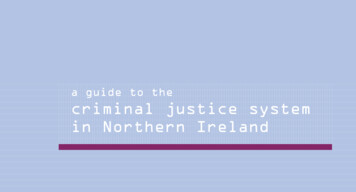
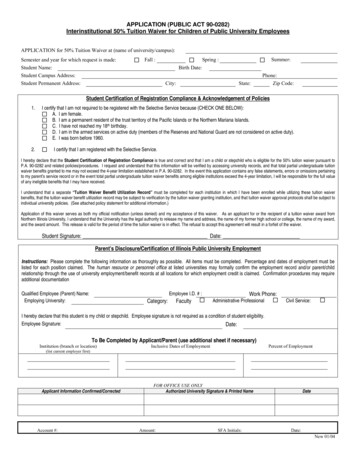
![05[2] Strategy competitors, competitive rivalry .](/img/2/052-strategy-competitors-competitive-rivalry-competitive-behavior-and-competitive-dynamics.jpg)
